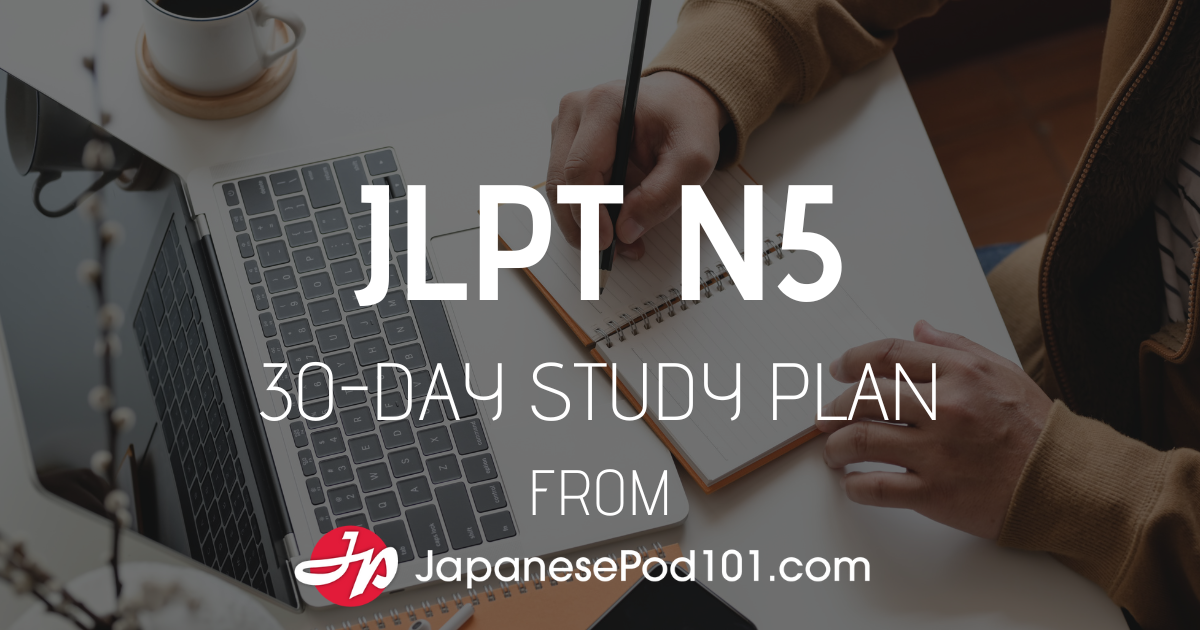
1. Can 75 Minutes a Day Really Get You JLPT N5-Ready?
Over 70% of first-time test-takers pass the JLPT N5 with just 100 hours of prep, according to JLPT official statistics. That’s about 3 hours per week over several months. But if you’re short on time or aiming for the next test date, there’s another path: 30 days of focused, consistent study.
We have prepared a plan that delivers a daily roadmap to pass the JLPT N5, Japanese Language Proficiency Test’s easiest level. This plan delivers a daily roadmap that will help you pass without burning out or falling off track.. You will use JapanesePod101’s pathways to help you pass the JLPT N5. You will find ebooks, practice tools, and proven methods like spaced repetition flashcards.
2. How This 30-Day Plan Works

This JLPT N5 study plan is a daily schedule designed for absolute beginners who want to pass the JLPT N5 in 30 days. For people interested in basic Japanese learning on a fast schedule, this plan works wonders.
A 30-day plan lets you compress spaced repetition into a high-frequency cycle. Rather than stretching learning over 3 months with large gaps in between, this plan makes Japanese a daily habit.
The daily commitment is about 75 minutes. Each day splits between passive learning (like listening) and active review (like writing or speaking). The core content consists of 150 lessons from JapanesePod101’s JLPT N5 Course 1 and the JLPT N5 Course 2, organized to maximize retention using research-backed learning methods.
It combines the following:
- JapanesePod101 audio/video lessons (12–15 minutes each)
- Vocab drills based on frequency lists
- Explanations of basic grammar
- Reading and writing hiragana, katakana, and beginner kanji
- Weekly quizzes and checkpoints
- A final exam
3. How This Plan Aligns with Cognitive Language Science

The 30-day structure isn’t arbitrary, it’s built on real research. We will explore 3 concepts that JapanesePod101 is leveraging to create this short, yet effective study plan. These are The Spaced-repetition system, interleaved practice, and retrieval-based learning.
1. The Spaced-Repetition System
Spaced repetition is a memory technique that spaces reviews over increasing intervals. In spaced repetition, you review a word just before you’re likely to forget it. This works because people remember information better when they review it with longer breaks in between. Cramming all at once is not as effective.
This approach:
- Minimizes time spent on words you already know
- Reinforces weak points by surfacing tricky words more often
- Mirrors the “forgetting curve” to keep knowledge fresh
JapanesePod101’s built-in flashcard tool is powered by this method. Here’s how it works:
| Feature | How it Helps |
| Smart Scheduling | Automatically schedules reviews based on how well you remembered the word last time |
| Audio & Example Sentences | Reinforces not just the meaning but also pronunciation and usage |
| Custom Word Lists | Lets you create personalized decks from lesson vocab or grammar points |
| Mobile Sync | Review anytime, anywhere, perfect for daily short study bursts |
Example Use in the 30-Day JLPT N5 Study Plan
This method fits naturally with the JLPT prep cycle.This method will help you memorize around 800 vocabulary words and 110 N5 kanji without feeling overwhelmed.
For this calendar, learners can:
- Add each day’s kanji and vocab into the JapanesePod101 flashcard system
- Use the SRS review session during commute or before bed (~10–15 min/day)
- Combine with the “Daily Two-Slot System” (e.g., flashcards in the morning, lessons at night)
2. Interleaved Practice
Instead of learning grammar, vocabulary, and listening separately, this plan combines them. For example, you listen to a grammar lesson and then review kanji. We call this technique interleaved practice.
Research from the Journal of Experimental Psychology shows interleaved practice improves retention and transfer of knowledge across contexts. Instead of studying all vocabulary first, then grammar, then listening, learners alternate between them. This variety forces the brain to stay alert and strengthens connections between concepts.
JapanesePod101’s structured course playlists naturally apply this technique by blending grammar explanations, listening practice, vocabulary drills, and cultural tips across each lesson.
3. Retrieval-Based Learning
Each review quiz throughout the course forces learners to recall information actively rather than passively re-read it. This process, known as retrieval practice, is one of the most scientifically supported techniques for building long-term memory. By challenging your brain to pull information from memory, rather than simply recognizing it, you create stronger neural connections and improve your ability to retain what you’ve learned over time.
To make the most of this technique, learners can take advantage of the Lesson Quiz feature. This feature is available after most lessons on JapanesePod101’s dashboard. These short, auto-graded quizzes act as practice tests that reinforce key grammar, vocabulary, and comprehension points. They’re ideal for daily review, so you’re consistently recalling what matters most for the JLPT N5, right when your brain needs it.
4. Daily Breakdown

Each day focuses on core grammar, listening skills, and vocab building. You’ll reinforce new information through kana drills, kanji writing, and quizzes.
JapanesePod101’s data shows that the average JLPT N5 lesson takes about 12.3 minutes to complete. It also shows that users who finish 4 to 5 lessons each day have the highest JLPT N5 pass rates.
All the resources needed to follow the JLPT N5 calendar below can be accessed here:
- Audio & Video Lessons from the JLPT N5 Course 1 (90 lessons)
- Audio & Video Lessons from the Lessons JLPT N5 Course 2 (60 lessons)
- Daily hiragana and katakana with the kana ebook and the audio & video course how to write Japanese: hiragana & katakana
- Daily kanji from the JLPT N5 kanji ebook
- Vocabulary reinforcement using flashcards (included the JLPT Courses)
- Weekly practice quizzes (included the JLPT Courses)
- BONUS! Learn Hiragana in 1 Hour with our hiragana compilation:
Printable JLPT N4 Calendar
| Day | JLPT N5 Lessons | Hiragana/Katakana to Learn | Kanji to Learn |
| 1 | Course 1 – L1–5 | あ, い, う | 一, 二、三, 四 |
| 2 | Course 1 – L6–10 | え, お, か | 五, 六, 七, 八 |
| 3 | Course 1 – L11–15 | き, く, け | 九, 十, 百, 千 |
| 4 | Course 1 – L16–20 | こ, さ, し, す | 万, 月, 火, 水 |
| 5 | Course 1 – L21–25 | せ, そ, た | 木, 金, 土, 日 |
| 6 | Course 1 – L26–30 | ち, つ, て | 上, 下, 中, 右 |
| 7 | Course 1 – L31–35 | と, な, に | 左, 東, 西, 南 |
| 8 | Course 1 – L36–40 | ぬ, ね, の | 北, 口, 目, 耳 |
| 9 | Course 1 – L41–45 | は, ひ, ふ, へ | 手, 足, 力, 人 |
| 10 | Course 1 – L46–50 | ほ, ま, み | 子, 男, 女, 父 |
| 11 | Course 1 – L51–55 | む, め, も | 母, 名, 友, 時 |
| 12 | Course 1 – L56–60 | や, ゆ, よ | 間, 午, 後, 前 |
| 13 | Course 1 – L61–65 | ら, り, る | 今, 年, 半, 分 |
| 14 | Course 1 – L66–70 | れ, ろ, わ | 毎, 週, 学, 校 |
| 15 | Course 1 – L71–75 | を, ん | Review first 56 kanji |
| 16 | Course 2 – L1–5 | あ (katakana), イ | 先, 生, 雨, 花 |
| 17 | Course 2 – L6–10 | ウ, エ, オ | 魚, 空, 山, 川 |
| 18 | Course 2 – L11–15 | カ, キ, ク | 天, 気, 田, 牛 |
| 19 | Course 2 – L16–20 | ケ, コ, サ, シ | 馬, 貝, 大, 小 |
| 20 | Course 2 – L21–25 | ス, セ, ソ | 高, 安, 多, 少 |
| 21 | Course 2 – L26–30 | タ, チ, ツ | 長, 古, 新, 早 |
| 22 | Course 2 – L31–35 | テ, ト, ナ | 行, 来, 食, 飲 |
| 23 | Course 2 – L36–40 | ニャ*, ニュ*, ニョ* | 見, 言, 話, 読 |
| 24 | Course 2 – L41–45 | ハ, ヒ, フ | 聞, 出, 入, 書 |
| 25 | Course 2 – L46–50 | ヘ, ホ, マ | 休, 会, 買, 立 |
| 26 | Course 2 – L51–55 | ミ, ム, メ | 駅, 車, 社, 店 |
| 27 | Course 2 – L56–60 | モ, ャ, ュ | 道, 電, 門, 円 |
| 28 | Course 2 – L61–65 | ョ, リャ*, リュ* | 何, 白, 本, 外 |
| 29 | Course 2 – L66–70 | リョ*, ワ, ヰ* | 国、語 |
| 30 | Course 2 – L71–75 | Characters review | Review 110 kanji |
5. Study Hacks to Stay on Track

Building a study habit isn’t just about willpower, it’s about structure. Luckily, there are a few study hacks that make it easier to stay accountable and consistent.
1. The “Two-Slot” System
Break your daily study into two manageable sessions, for better retention and energy management. For example, you might split your 75-minute study block into two parts:
- Slot 1 (morning/commute): 30–40 minutes of passive audio listening
- Slot 2 (evening): 35–45 minutes of writing, reviewing, or quizzing
This taps into spaced exposure and gives your brain a rest between sessions.
2. Habit Stacking

Use James Clear’s “habit stacking” technique to attach learning to something you already do. You can pair study tasks with your daily routines, to multi-task while you’re learning Japanese.
For example, review flashcards while having your morning coffee. You can also listen to a lesson during your commute. This allows you to build easy and automatic study habits.
The JapanesePod101 mobile app makes this especially easy: you can download audio lessons, access your flashcard decks, and take quizzes. You can do all this without interrupting your daily routine.
With everything just a tap away, habit-stacking your way to JLPT success becomes part of your everyday life. Here is an example of what it can look like:
| Habit | Stack With |
| Morning coffee | Review 10 N5 vocab flashcards |
| Shower time | Listen to a podcast or JapanesePod101 audio |
| Lunch break | Write 5 hiragana words from memory |
3. Social Learning & Accountability
Post weekly progress screenshots in a Reddit group, Discord, or language-learning community. Boosts motivation and consistency by sharing progress with others and committing publicly to your study goals.
6. Common Pitfalls & How to Avoid Them
Even with a solid plan, motivated learners can stumble and can get derailed. This section outlines the most frequent traps that learners fall into, and shows you how to sidestep them with smarter strategies:
Pitfall 1: Ignoring Listening Practice
Many N5 learners focus on kanji and vocab but forget listening. But listening comprehension is 33% of the test. That makes the listening section a major part of the grade.
How to Fix: Listen daily. This will be easier for you if you choose to follow the calendar and follow the JLPT N5 course 1 & 2.
Also, passive exposure counts, so replay lessons even if you’re cleaning or commuting.
Pitfall 2: Relying Only on Flashcards
Flashcards help vocabulary, but don’t teach context, grammar, or listening skills.
How to Fix: Combine flashcards with full sentence examples, shadowing practice, and grammar-focused lessons.
Pitfall 3: Skipping Kana Reviews
Rushing through kana in one sitting can lead to confusion later. Confusing さ and ち or mixing up ソ and ン in katakana is common if you don’t review properly.
How to Fix: Spend 5 minutes daily on kana, even if you “already know it.” It sharpens your visual recognition. Apart from that, also try watching our Hiragana Video Series for bite-sized refreshers.
Pitfall 4: Skipping Weekly Reviews
Without reviewing, you’ll forget 60–70% of what you studied, based on Ebbinghaus’s forgetting curve.
How to Fix: Do the weekly quizzes! It’s your memory’s insurance policy.
7. Motivation: Why JLPT N5 Matters
Passing the JLPT N5 opens small but exciting opportunities. This will also help build a strong foundation for taking the JLPT N4 test and higher levels, all the way through to JLPT N1. And best of all, you will be able to do things such as:
- Read basic signs, menus, and train instructions in Japan
- Unlock reading ability for simple manga, websites, and subtitles
- Show your commitment to employers, language schools, friends and family
Frequently Asked Questions about the JLPT N5 Study Plan
- How many Kanji do I need for the JLPT N5?
Around 100-120 Kanji. This plan includes daily practice from our Kanji ebook.
- Should I learn hiragana and katakana first?
Yes. The first 5-7 days focus on kana, and include built-in daily writing practice.
- Is JapanesePod101 free?
Yes, you can sign up for a free account to access the core N5 lessons and resources
Ready to Start Day 1? Your first lesson is waiting. You only need 75 minutes today! Sign up for free at JapanesePod101.









